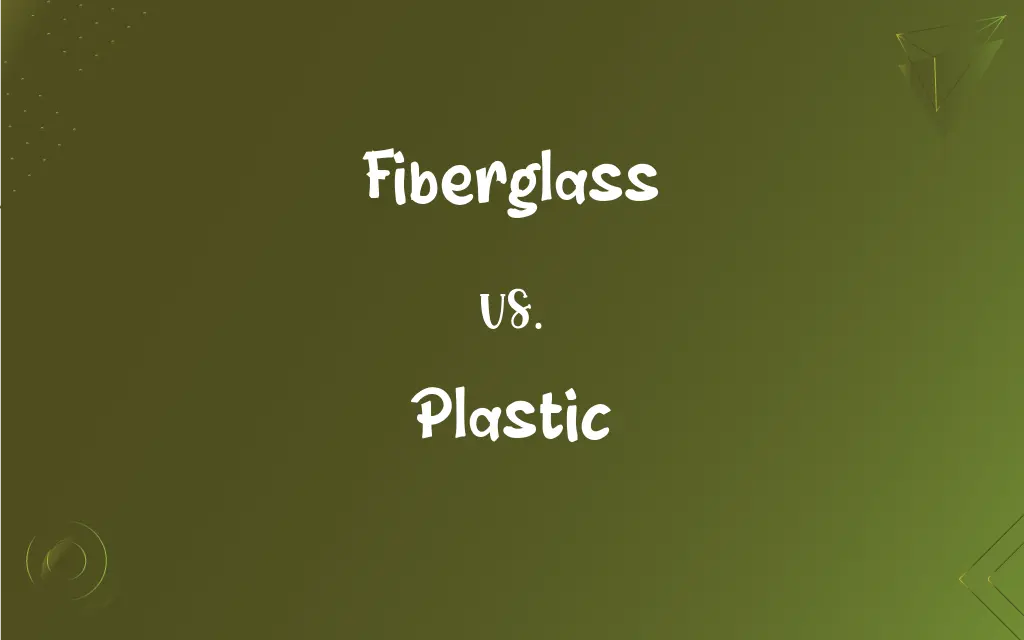Fiberglass vs. Plastic: What's the Difference?
Edited by Aimie Carlson || By Harlon Moss || Updated on October 19, 2023
Fiberglass is a reinforced polymer material made of fine glass fibers, while plastic is a synthetic or semi-synthetic organic material that can be molded.

Key Differences
Fiberglass and plastic are both popular materials in various industries, having unique properties that make them useful. Fiberglass is essentially a composite material made of fine strands of glass woven into fabric and then reinforced with a resin. Its strength is derived from these individual glass fibers, which are incredibly strong for their size. On the other hand, plastic is a broad term for synthetic or semi-synthetic materials that can be molded into various shapes and forms.
While fiberglass offers strength due to its glass reinforcements, it maintains a lightweight nature, making it suitable for products like boat hulls or car bodies. Plastic's primary advantage lies in its versatility. Depending on its chemical makeup, plastic can be hard like polystyrene or soft like polyethylene, lending itself to a vast array of applications from toys to automotive components.
From an environmental standpoint, fiberglass and plastic both present challenges. Fiberglass can be difficult to recycle because of its composite nature, whereas plastic, though recyclable, has raised environmental concerns due to its non-biodegradable nature and its significant presence in ocean pollution. It's worth noting, however, that many initiatives are underway to create biodegradable plastics and improve fiberglass recycling techniques.
The production processes for fiberglass and plastic differ significantly. Making fiberglass involves pulling molten glass through fine holes to create fibers, which are then woven and set with resin. In contrast, plastic production often involves the polymerization of organic compounds derived from oil or natural gas, resulting in various types of plastics with distinct properties.
Comparison Chart
Composition
Fine strands of glass combined with resin.
Synthetic or semi-synthetic organic compounds.
ADVERTISEMENT
Strength
High strength due to glass reinforcements.
Varies widely based on type.
Environmental Impact
Difficult to recycle, less ocean pollution.
Non-biodegradable, significant ocean pollution.
Production Process
Involves molten glass and weaving.
Polymerization of organic compounds.
Key Uses
Boat hulls, car bodies, insulation.
Toys, packaging, automotive components, daily items.
Fiberglass and Plastic Definitions
Fiberglass
A composite material made of glass fibers.
The boat's hull was constructed of fiberglass for added strength.
ADVERTISEMENT
Plastic
A synthetic or semi-synthetic moldable material.
The toy was made of brightly colored plastic.
Fiberglass
A woven fabric created from fine strands of glass.
He wore protective gloves when handling the fiberglass fabric.
Plastic
A versatile material with a range of properties.
The plastic used in this container is flexible and transparent.
Fiberglass
A material known for its strength and lightweight properties.
Race cars often use fiberglass components to reduce weight.
Plastic
A substance derived from petrochemicals.
This plastic bottle originates from petroleum-based compounds.
Fiberglass
A substance resistant to heat and electricity.
The insulation in the attic is made of fiberglass.
Plastic
A term describing something as fake or artificial.
His smile seemed so plastic and insincere.
Fiberglass
A durable material commonly used in construction.
The new building features a modern fiberglass facade.
Plastic
Material known for its recyclability, though often a pollutant.
The beach cleanup focused on removing plastic waste.
Fiberglass
A material consisting of extremely fine glass fibers, used in making various products, such as yarns, fabrics, insulators, and structural objects or parts. Also called spun glass.
Plastic
Capable of being shaped or formed
Plastic material such as clay.
Fiberglass
A lightweight, durable material consisting of synthetic resin reinforced with such fibers, used in applications such as roofing and boatbuilding.
Plastic
Relating to or dealing with shaping or modeling
The plastic art of sculpture.
FAQs
Can both fiberglass and plastic be recycled?
While both can be recycled, fiberglass recycling is more challenging, and not all plastics are recycled effectively.
Which is more durable, fiberglass or plastic?
It depends on the application; fiberglass offers high strength, but some plastics can be very durable too.
Why is fiberglass often used in boat construction?
Due to its strength, lightweight nature, and resistance to water.
Are all plastics harmful to the environment?
Many are non-biodegradable, but there are also biodegradable plastics.
What's the primary component of fiberglass?
Fine strands of glass.
How are plastics categorized?
By their polymer chains, e.g., polyethylene, polypropylene.
Can plastic melt?
Many plastics can melt when exposed to high temperatures.
How is the strength of fiberglass achieved?
Through the combination of fine glass fibers and resin.
What's a primary use of fiberglass in homes?
Insulation.
Are fiberglass items always hard and rigid?
Mostly, but the resin's type can influence its flexibility.
Why do some people prefer plastic products?
Plastic can be lightweight, durable, and moldable into various shapes.
Is fiberglass resistant to electricity?
Yes, it's an insulator and doesn't conduct electricity.
Is fiberglass fire-resistant?
While it's not entirely fireproof, it's more resistant than many other materials.
What's a common environmental concern with plastic?
Plastic waste, especially in oceans, is a significant concern.
Are plastics naturally occurring?
Most are synthetic, but some semi-synthetic plastics derive from natural substances.
How is plastic's flexibility achieved?
Through the inclusion of specific chemical additives or plasticizers.
Is fiberglass a type of plastic?
No, fiberglass is a composite material made of glass fibers and resin, while plastic is organic-based.
What makes plastic so versatile?
Its molecular structure can be altered to possess various properties.
Does fiberglass break easily?
While strong, it can crack or break under significant force.
Can fiberglass be used for insulation?
Yes, it's a popular insulation material for homes.
About Author
Written by
Harlon MossHarlon is a seasoned quality moderator and accomplished content writer for Difference Wiki. An alumnus of the prestigious University of California, he earned his degree in Computer Science. Leveraging his academic background, Harlon brings a meticulous and informed perspective to his work, ensuring content accuracy and excellence.
Edited by
Aimie CarlsonAimie Carlson, holding a master's degree in English literature, is a fervent English language enthusiast. She lends her writing talents to Difference Wiki, a prominent website that specializes in comparisons, offering readers insightful analyses that both captivate and inform.
































































